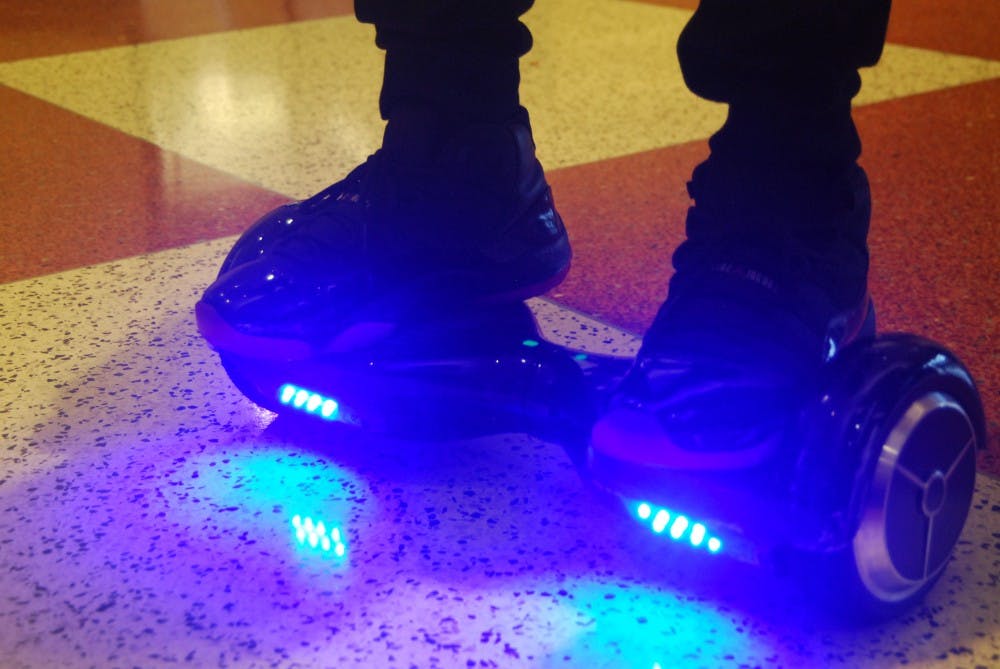Some call them hoverboards, others call them mini-Segways, but the companies who sell them use “self-balancing scooters.” What started as a mildly popular accessory among celebrities like rapper Wiz Khalifa and actor Quincy Brown has trickled down from the masses to Elon University’s campus.
To hoverboard the user shifts weight forward, and the board moves forward and vice versa. To stand still on the scooter, the user must distribute weight evenly in the middle of both feet. Spinning in a circle requires the user to tip the outer foot either forward or backward while keeping weight on the other foot evenly distributed.
Most hoverboards come with LED lights that are activated when the scooter is in motion. It takes two or three hours to fully charge the board for up to six hours of constant riding. For students using it to get from class to class, the battery can last all day.
Though it may sound complicated, riding the scooter is surprisingly easy once you get the hang of it, according to junior Demetrius Oliver. When starting out, it may be helpful to try it on a flat but soft surface indoors to minimize injury in case of a fall. The hoverboards work on anything from asphalt to carpet, as long as the terrain is relatively smooth.
Hoverboarding around Elon
On sidewalks, in hallways and even on main roads, students can be seen moving around on scooters of all colors and models, getting around a few miles per hour faster than everyone else.
Oliver, starting wide receiver for the Elon University football team, got his hoverboard because he wanted a more fun form of transportation.
“One of the guys on the team got one and we all tried it out,” he said. “It seemed fun, so I got one.”
He bought one in late September on Amazon.com for $290. Looking back, the investment, which may seem steep to some, was about much more than following in the footsteps of a fellow football player.
“It’s an easier and faster way to get around campus,” Oliver said. “It’s also less taxing on the legs. Being that I’m an athlete, it’s a good option.”
To get to class, he drives from his Crest apartment, parks in the Colonnades lot and rides the scooter across campus.
Though it may require less legwork, riding these scooters is a test of core strength and balance. Shifting weight to execute turns, maneuvering around pedestrians and riding across bumps or inconsistent terrain presents challenges to a hover board rider. Oliver admits he has fallen a few times, but he has gotten so confident with his skills, he puts himself to the ultimate test.
“I have a son,” Oliver said, “and I hold him while I ride it. He loves it.”
With his one-year-old in tow, Oliver spins in circles and rides around his apartment alongside teammate and fellow hoverboard owner, sophomore Daniel Everett.
Everett purchased his hover board at a mall in Greensboro just before Oliver, his roommate, got his. Everett paid $400 for it, more costly than Oliver’s because of the addition of bumpers. Along with the plastic bumpers around the wheels, Everett’s board has a shimmery gold paint job.
Even with the higher price and flashy upgrades, Everett is not afraid of damaging his scooter. In fact, when other students see him riding it and ask for a test drive, he rarely says no.
“As long as they sign the verbal liability waiver in case they fall off,” he said, jokingly.
Safety precautions
With the influx of hover board use on campus, some students have compared the scooters to Heelys, a shoe brand that became popular in the early 2000s for sneakers with wheels hidden in the heels. In schools across the nation, these shoes were banned due to safety concerns.
In the United Kingdom, regulations for hoverboard use have already been established. The “self-balancing scooters” are being treated like Segways — they are only approved for use on private property because they do not meet criteria for proper licensing necessary for public use.
So far, these kinds of strict regulations have not been imposed in the United States, where there is not much of a precedent of Segway usage. As the scooters get more popular, more rules may come, but for now, Elon Campus Safety and Police will be filing the hoverboards under the same category as skateboards, roller blades and inline skates.
When asked in an email about the university’s policy toward hover boards, Elon University Chief of Police Dennis Franks said, “the student handbook covers this type of conveyance.”
The handbook has not been updated to include hover boards, but because they are being treated like other small transportation devices, the policy is strict:
The boards can be used on campus, but not on sidewalks or streets in the Town of Elon, the handbook said. Users are expected to wear protective gear — helmets, elbow pads and kneepads — at all times to avoid injury, for which the university is not liable.
To answer the question on everyone’s minds: “these activities are not allowed inside any building and grinding and rail sliding are not permitted at all,” according to the handbook.
The policies are clear, but so is the popularity of the two-wheeled toy. As more and more students invest in the trend, it seems hoverboards may be here to stay.


